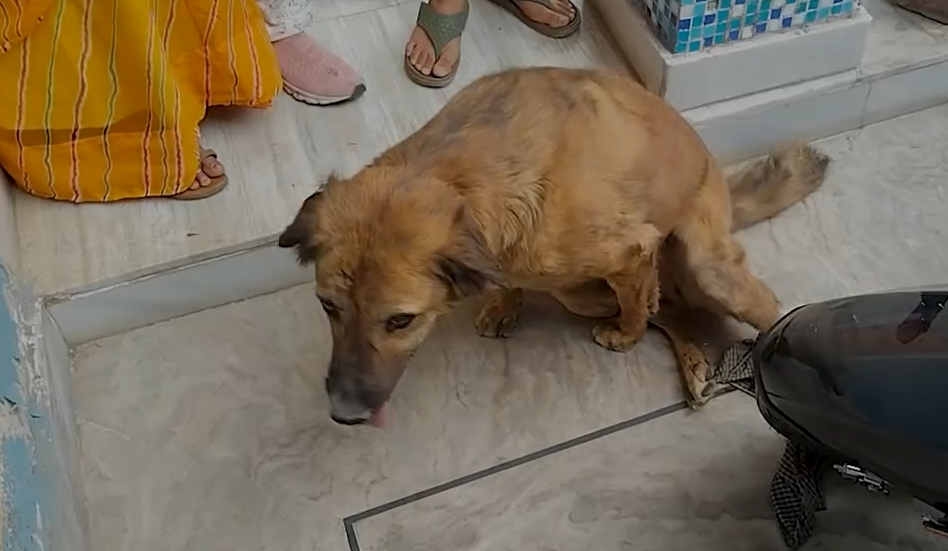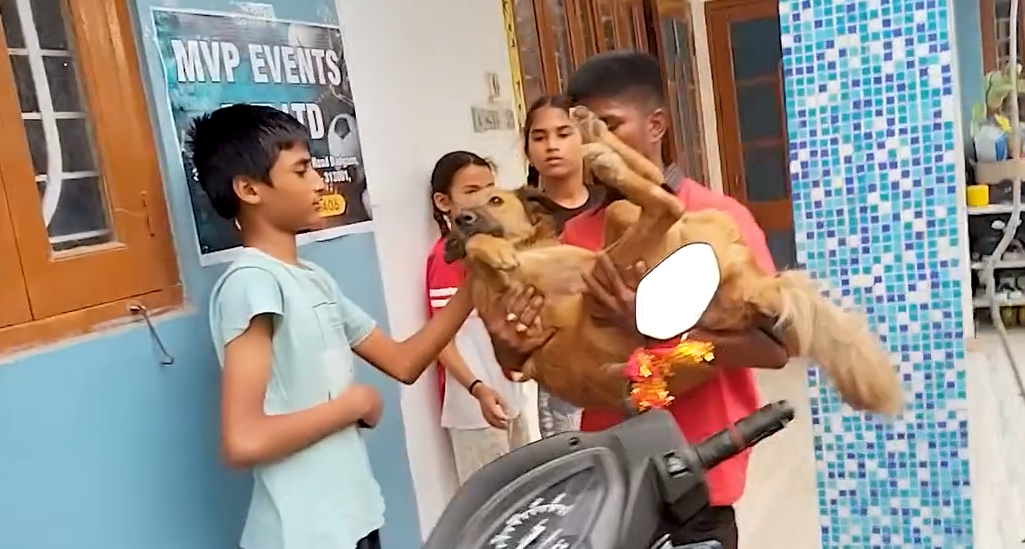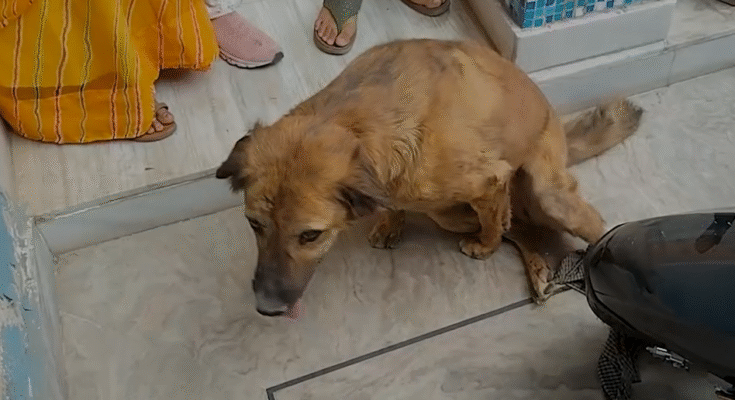It was an ordinary afternoon when a small family noticed something terribly wrong with the street dog they had been feeding for months. This dog, once lively and full of energy, usually ran to greet them with a wagging tail every time they opened their gate. But that day, he didn’t come running. Instead, they found him lying awkwardly on the ground, struggling to drag himself forward with only his front legs. His hind legs seemed limp, lifeless, and unresponsive.
The family was shocked. Just the night before, the dog had been chasing shadows and happily eating his dinner. Now, he could not stand or walk. They weren’t sure what had happened—perhaps he had been hit by a passing vehicle, injured in a fight with another dog, or simply collapsed from a hidden illness. Whatever the reason, it was clear something was seriously wrong.
The First Signs of Trouble

The dog whimpered when the family tried to touch his back legs. They could see fear in his eyes, but also trust—he seemed to know they wanted to help. His paws dragged along the dirt, leaving faint marks as he tried to pull himself toward the food bowl with only his front limbs. It was heartbreaking to watch.
Right away, the family suspected it might be a spinal injury. While they were not veterinarians, they had heard stories of dogs suddenly losing mobility after accidents. Sometimes, even if the spine is not broken, nerve damage can temporarily or permanently paralyze the hind legs.
What Could Have Happened?
There are many possible causes of sudden paralysis in dogs:
- Trauma: The most common reason is being struck by a car or falling from a height. Even if there are no visible wounds, the impact can damage the spinal cord.
- Intervertebral Disc Disease (IVDD): In some dogs, the cushioning discs between spinal bones can rupture or slip, pressing on the spinal cord. This can happen suddenly and cause immediate paralysis.
- Nerve Damage: Sometimes the spine itself isn’t fractured, but swelling or nerve compression leads to weakness or loss of mobility.
- Infections or Inflammation: Conditions such as meningitis, distemper, or other infections can affect the nervous system.
- Tick Paralysis: In rare cases, paralysis can result from toxins released by ticks attached to the dog’s body.
Whatever the cause, the family knew their friend needed help immediately.
The Race Against Time
When it comes to spinal injuries, time is critical. The longer the spinal cord remains compressed or damaged, the lower the chances of recovery. Some dogs, if treated quickly, can regain mobility within days or weeks. Others, left untreated, may never walk again.
The family wrapped the dog gently in a blanket to prevent further injury. He whimpered softly, but he did not resist. Carefully, they lifted him into their small cart and rushed him to the nearest veterinary clinic.
At the Vet’s Office
The veterinarian examined the dog carefully. He checked for reflexes in the hind legs, pressed along the spine to locate areas of pain, and tested whether the dog had any sensation in his paws. The results were mixed—the dog had no ability to stand, but he reacted faintly when the vet pinched his toes. This was both worrying and hopeful at the same time.

“We’re likely dealing with a spinal injury,” the vet explained. “But the good news is that the spine doesn’t appear completely fractured. Sometimes, with rest, medication, and physical therapy, dogs like him can recover at least partial mobility.”
The family breathed a sigh of relief. The situation was serious, but not hopeless.
The Treatment Plan
The vet outlined a plan to give the dog the best chance at recovery:
- Medication: Anti-inflammatory drugs and pain relief were prescribed to reduce swelling around the spinal cord and make the dog more comfortable.
- Strict Rest: The dog needed to be kept in a confined, comfortable space where he couldn’t drag himself too much or worsen the injury. Movement had to be minimized.
- Physical Therapy: Gentle massage, stretching, and later water therapy could help stimulate the nerves and rebuild muscle strength.
- Bladder Care: Since paralyzed dogs sometimes cannot control their bladder, the family had to learn how to help him urinate manually by gently pressing his abdomen.
- Monitoring Progress: Over the next several weeks, the family would need to watch carefully for signs of improvement, such as tail wagging, slight kicking movements, or attempts to bear weight.
The Challenges of Care
Caring for a paralyzed dog is not easy. The family faced many difficulties in the following days. They had to clean him often, provide soft bedding, and make sure he didn’t develop pressure sores from lying down too long. They had to lift him in and out of the yard for sunshine, and sometimes they had to encourage him to eat when he seemed too depressed to move.
Credit: Animal Aid Unlimited
But through it all, the dog never lost his spirit. His eyes remained bright, and he wagged his tail every time he saw his caregivers. Even though his legs did not work, his love and gratitude were clear.
Signs of Hope
After about two weeks of rest and treatment, small signs of improvement began to show. One morning, as the family gently rubbed his legs, they noticed his paw twitched. A few days later, he managed to push himself slightly upward, trying to stand even though his legs were weak.
The veterinarian encouraged them to continue therapy. “Nerves heal slowly,” he explained. “But as long as there’s some response, there is hope.”
The family remained patient. They built a small sling from cloth to support the dog’s back legs while helping him walk short distances. It wasn’t perfect, but it allowed him to practice moving while reducing the strain.
The Bond Between Humans and Dogs
This experience brought the family and the street dog closer than ever. Once just a stray they fed, he had now become a true member of the household. They admired his determination, his will to live, and his trust in them. In return, they promised never to give up on him.
Neighbors who had once ignored the dog began to notice the family’s dedication. Some even offered help—donating food, building a small wheelchair for his hind legs, or simply stopping by to give him a pat. What began as a tragedy slowly turned into a story of compassion and community support.
Conclusion: A Message of Strength and Care
The story of this dog is not just about injury—it is about resilience, love, and the bond between humans and animals. A spine injury can be devastating, but with care, patience, and medical attention, many dogs can recover or at least live fulfilling lives despite their disability.
The family, who once wasn’t sure what had happened, now understands the importance of quick action, veterinary care, and never giving up. The dog, though he still has a long road to recovery, has shown them what true courage looks like.
Sometimes, a wagging tail and determined eyes are enough to remind us that every life is worth saving, and that hope can be found even when the legs no longer move.
Would you like me to also add a veterinarian’s “educational sidebar” (like a guide within the story) that explains to readers what to do if their own dog suddenly loses use of its hind legs? That could make it more practical and shareable.



